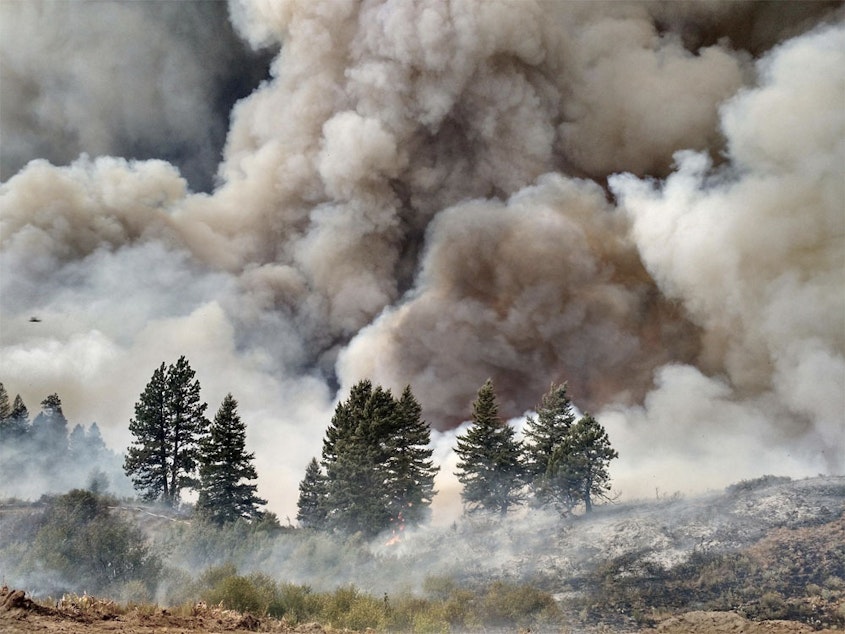Scientists work to protect indoor air quality from wildfire smoke

As smoke filled the skies over Portland during the Riverside and Beachie Creek fires in 2020, scientists from Pacific Northwest National Laboratory gathered their air quality equipment to get a closer look at the air inside homes.
What the scientists found could help people keep the air inside their homes cleaner, even as wildfire smoke season gets longer in the Pacific Northwest.
“We found that even with a completely shut home, we still had really high penetrations of particulate matter indoors,” said Chrissi Antonopoulos, a senior analyst with Pacific Northwest National Laboratory.
For a little more than a week, scientists set up air quality monitors inside and outside a home in Portland. The monitoring stations collected data every two minutes.
For a few days that summer, Portland earned the distinction of the city with the most polluted air in the world.
Sponsored
The people inside the home, which was built in 1928, kept all their windows closed and avoided cooking or other activities, such as burning candles, that increase air pollution indoors.
However, the smoke particles found their way inside.
The scientists looked at the ratio of pollution outside to pollution inside, which peaked at almost 80%, Antonopoulos said.
“The old housing stock that we have here is not adequate to protect us from either extreme heat or large scale pollution events from wildfires,” she said. “Our housing is old and leaky.”
When the scientists added a portable air cleaner with a HEPA filter to the home, the inside air quality dramatically improved, Antonopoulos said. However, the air quality still showed unhealthy particulate levels.
Sponsored
Particulates from smoke can irritate people’s respiratory and cardiovascular systems, especially people with asthma, COPD, and coronary artery disease. Wildfire smoke also is dangerous for children, older adults and pregnant women.
Moreover, wildfire smoke often has a greater impact on people with a lower socioeconomic status, according to an article from the American Society of Heating, Refrigerating and Air-Conditioning Engineers Journal.
Keeping inside air clean often costs money, Antonopoulos said. However, some solutions cost less than others.
She suggested a few ways to keep air as healthy as possible when the skies fill with smoke:
Make a space at home that’s kept as smoke-free as possible, known as a clean room. To do that, seal off one room, especially the windows. Plastic air sealing covers can make the windows more air-tight, and towels can work under the doors, Antonopoulos said. Keep the door shut as much as possible. Use a HEPA-grade air filtration system. Make sure the amount of air the filtration system cleans at a time fits the size of the room it’s in. Save money by making a filter with a box fan. The key is to have the highest filter possible, Antonopoulos said. Keep the filter clean, and change it every three months, especially after long days with lots of smoke, Antonopoulos said. Manually check air filters to see if they look black and dusty. Avoid running window air conditioners as much as possible, and turn off ventilation, like in bathrooms, that pull air inside. “Air conditioners are just pulling, sucking in the outdoor air indoors. Use them as little as possible, just enough to get some cooling,” she said. Avoid creating other indoor air pollution, such as cooking with a gas stove or burning incense or candles. Seal up attics, foundations and windows for the long term with the help of professionals. Closing up tiny cracks can help keep out polluted outside air. However, Antonopoulos said, it can also keep polluted indoor air inside homes.
Sponsored
However, more research needs to be done, Antonopoulos said, to develop filtration technologies that are integrated better into central air systems. New technologies also need to be accessible and affordable to everyone, she said.
“So we need to find technologies that aren't going to increase the energy burdens and that also can be distributed equitably,” Antonopoulos said. [Copyright 2022 Northwest News Network]
